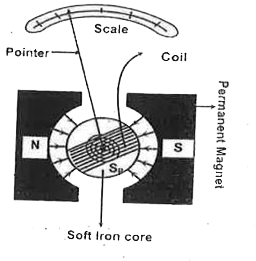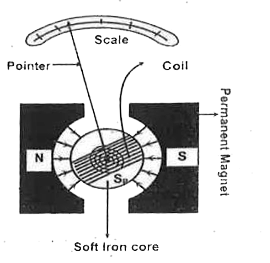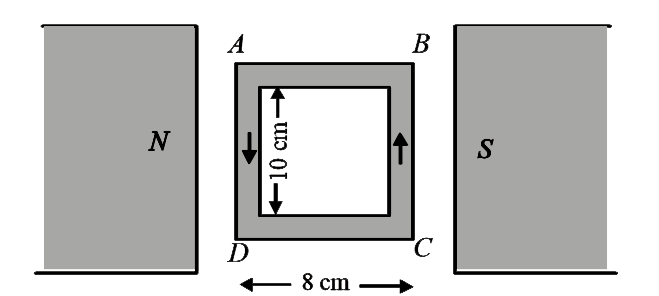Analog voltmeters and ammeters work b measuring the torque exerted by a megentic field on a current carrying coil. The reading is displayed by means of the deflection of a pointer over a scale. The adjacent figure shows the essentials of a galvanometer, on which both analog ammters and analog voltmeters are based. Assume that the coil is 2.1 cm high, 1.2 cm wide has 250 turns and is mounted so that it can rotate about an axis (into the page) in a uniform radial magnetic field with B = 0.23 T. for any orientation of the coil, the net magnetic field through the coil is perpendicular to the normal vector of the coil (and thus parallel to the plane of coil) A spring SP provides a counter torque that balance the magnetic torque so that a given steady current I in the coil results in a steady angular diflection ϕ. The greater the current is greater the deflection is and thus greater the torque required of the spring is A current of 100 μA produces an angular deflection of 28∘.

What must be the torional conctant k of the spring ?
2.6×10−8 Nm/degree
5.2×10−8 Nm/degree
2.6×10−8 Nn/degree
5.2×10−4 Nm/degree
The correct Answer is:B
Topper's Solved these Questions
- MAGNETICBook:FIITJEEChapter:MAGNETICExercise:Comprehension -2
Explore 3 Videos
- MAGNETICBook:FIITJEEChapter:MAGNETICExercise:Comprehension -3
Explore 3 Videos
- MAGNETICBook:FIITJEEChapter:MAGNETICExercise:Assignment Problems (Level - II)
Explore 20 Videos
- LAWS OF MOTIONBook:FIITJEEChapter:LAWS OF MOTIONExercise:COMPREHENSION-III
Explore 2 Videos
- MAGNETISMBook:FIITJEEChapter:MAGNETISMExercise:Example
Explore 12 Videos
Similar Questions
Knowledge Check
Analog voltmeters and ammeters work b measuring the torque exerted by a megentic field on a current carrying coil. The reading is displayed by means of the deflection of a pointer over a scale. The adjacent figure shows the essentials of a galvanometer, on which both analog ammters and analog voltmeters are based. Assume that the coil is 2.1 cm high, 1.2 cm wide has 250 turns and is mounted so that it can rotate about an axis (into the page) in a uniform radial magnetic field with B = 0.23 T. for any orientation of the coil, the net magnetic field through the coil is perpendicular to the normal vector of the coil (and thus parallel to the plane of coil) A spring SP provides a counter torque that balance the magnetic torque so that a given steady current I in the coil results in a steady angular diflection ϕ. The greater the current is greater the deflection is and thus greater the torque required of the spring is A current of 100 μA produces an angular deflection of 28∘.

If the value of magnetic field is put equal to 0.69 T and K=15.6×10−8 nm/degree. Then the deflection would beA<28∘B=28∘C14∘Dnone of theseAnalog voltmeters and ammeters work b measuring the torque exerted by a megentic field on a current carrying coil. The reading is displayed by means of the deflection of a pointer over a scale. The adjacent figure shows the essentials of a galvanometer, on which both analog ammters and analog voltmeters are based. Assume that the coil is 2.1 cm high, 1.2 cm wide has 250 turns and is mounted so that it can rotate about an axis (into the page) in a uniform radial magnetic field with B = 0.23 T. for any orientation of the coil, the net magnetic field through the coil is perpendicular to the normal vector of the coil (and thus parallel to the plane of coil) A spring SP provides a counter torque that balance the magnetic torque so that a given steady current I in the coil results in a steady angular diflection ϕ. The greater the current is greater the deflection is and thus greater the torque required of the spring is A current of 100 μA produces an angular deflection of 28∘.

If we reduce the value of this K ti half of its value then the delection would beA28∘B56∘C14∘Dnone of theseIn a moving coil galvanometer the deflection (ϕ) on the scale by a pointer attached to the spring is
A(NAkB)IB(NkAB)IC(NABk)ID(NABkI)
The moving coil of a galvanometer 4 cm long and 1.5 cm wide, made of 200 turns of thin wire, works in a magnetic field with induction of 0.1 T. The plane of the coil is parallel to lines of induction. Find the torque acting on the coil when a current of 1 mA flows in it.
View SolutionThe moving coil of a galvanometer 4 cm long and 1.5 cm wide, made of 200 turns of thin wire, works in a magnetic field with induction of 0.1 T. The plane of the coil is parallel to lines of induction. Find the torque acting on the coil when a current of 1 mA flows in it.
View SolutionIn a moving coil galvanometer the deflection (ϕ) on the scale by a pointer attached to the spring is
View SolutionA 250 turn rectangular coil of length 2.1 cm and width 1.25 cm carries a current of 85 μA and subjected to a magnetic field of strength 0.85 T. Work done for rotating the coil by 180∘ against the torque is
View SolutionA 250-turns recantagular coil of length 2.1 cm and width 1.25 cm carries a current of 85μA and subjected to magnetic field of strength 0.85T. Work done for rotating the coil by 180∘ against the torque is
View Solution


